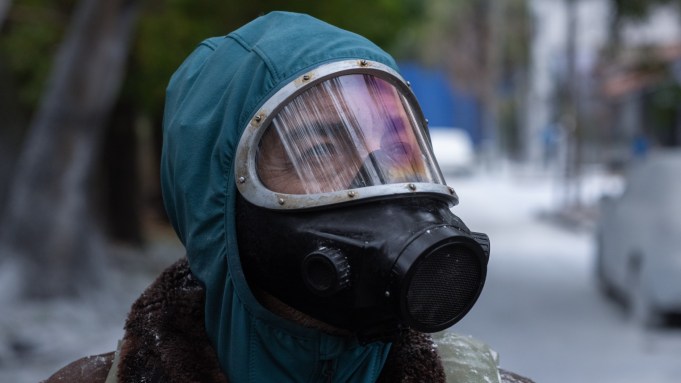
Credit: Netflix
Netflix used generative AI in an original, scripted series that debuted this year, it revealed this week. Producers used the technology to create a scene in which a building collapses, hinting at the growing use of generative AI in entertainment.
During a call with investors yesterday, Netflix co-CEO Ted Sarandos revealed that Netflix's Argentine show The Eternaut, which premiered in April, is "the very first GenAI final footage to appear on screen in a Netflix, Inc. original series or film.” Sarandos further explained, per a transcript of the call, saying:
The creators wanted to show a building collapsing in Buenos Aires. So our iLine team, [which is the production innovation group inside the visual effects house at Netflix effects studio Scanline], partnered with their creative team using AI-powered tools. ... And in fact, that VFX sequence was completed 10 times faster than it could have been completed with visual, traditional VFX tools and workflows. And, also, the cost of it would just not have been feasible for a show in that budget.
Sarandos claimed that viewers have been "thrilled with the results"; although that likely has much to do with how the rest of the series, based on a comic, plays out, not just one, AI-crafted scene.
More generative AI on Netflix
Still, Netflix seems open to using generative AI in shows and movies more, with Sarandos saying the tech "represents an incredible opportunity to help creators make films and series better, not just cheaper."
"Our creators are already seeing the benefits in production through pre-visualization and shot planning work and, certainly, visual effects," he said. "It used to be that only big-budget projects would have access to advanced visual effects like de-aging."
AI-generated video and images in shows or movies is a popular topic of discussion, but Netflix also has less divisive application ideas. During yesterday's call, Netflix co-CEO Greg Peters highlighted the potential for generative AI to improve Netflix's personalization and recommendation abilities. He said that Netflix is currently piloting the ability for people to ask Netflix for a recommendation via conversational prompts like, "I want to watch a film from the '80s that is a dark, psychological thriller."
Streaming services, TV manufacturers, and smart TV OS operators have been eager to leverage generative AI for superior search functionality that improves customers' chances of finding something to watch. For Netflix, better search capabilities could keep users engaged with the platform more, which is important for appealing to advertisers and keeping viewers subscribed.
Netflix previously announced that it will show interactive ads that use generative AI during shows and movies (for ad-tier subscribers) in 2026. On yesterday's call, Peters pointed to efforts to enable the use of generative AI "in more and more" advertising spots.
Sarandos previously said that Netflix's use of generative AI won't take from its goal of "telling great stories.” In a call with investors a year ago, he compared generative AI in TV and film to the growth of computer-generated animation, claiming that it improved animation and that "more people work in animation today than ever in history." According to the US Department of Labor, there were 73,300 special effects artists and animators in 2023, with 3,200 jobs expected to be added from 2023 to 2033.
"I’m pretty sure that there’s a better business—and a bigger business—in making content 10 percent better [using technology] than [there is in] making it 50 percent cheaper," Sarandos said at the time. He added that audiences “probably don’t care much about budgets and, arguably, maybe not even the technology to deliver it."
More generative AI in TV and film
The level of interest that audiences have in generative AI in TV and film will vary by person and situation.
Last year, people accused Netflix's true crime documentary What Jennifer Did of using undisclosed generative AI—a claim that executive producer Jeremy Grimaldi denied. Documentaries are supposed to be grounded in truth and evidence, so AI-generated imagery could hurt credibility. Contrastingly, using generative AI to avoid destroying a real building for use in a fictional apocalyptic drama is more understandable. Using generative AI to write the script for such a show, however, would likely evoke different reactions.
TV and films are expected to use generative AI more in the next few years as industry leaders like Disney explore ways to leverage the technology. Generative AI has already been used in theatrical releases, such as The Brutalist, creepy news broadcasts, clunky movies on free streaming services, and in cartoons. Generative AI can save money, making it a priority for the entertainment industry. The use and touting of generative AI in an original series from Netflix is likely to generate more interest.
Much of the discussion about generative AI in TV and film centers on the potential to undermine creativity and jobs, and rip off intellectual property. However, there's also a sincere push to understand how to use the tech to enhance creative, human ideas. As society learns what generative AI realistically will and won't do, how the technology is received in shows and movies will likely depend on how, when, and why it's used, as well as how open creators are about its usage.

-
 C114 Communication Network
C114 Communication Network -
 Communication Home
Communication Home


